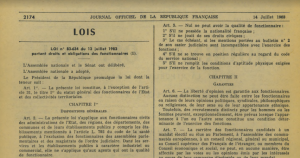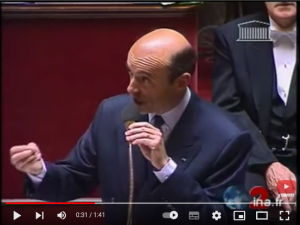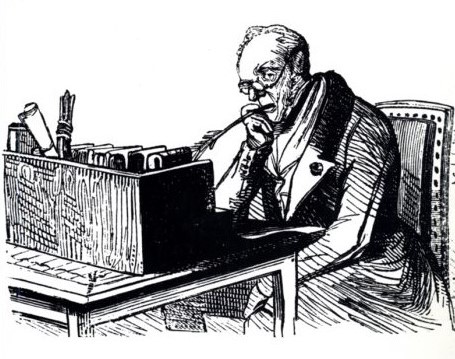


Human and Social Sciences at the Bedside of Health?
12 December 2021
Enforcing Constitutions: A Democratic Undertaking?
12 February 2022
Some presidential candidates are calling for a massive reduction in the number of civil servants: they are not cost-effective enough. There is nothing new about this belief. It even has a very long history, but not necessarily the one that might come to mind. By following its winding path over more than two centuries, Émilien Ruiz uncovers its many facets, which he has just revealed in his book Trop de fonctionnaires? Histoire d’une obsession française (XIXe-XXIe siècle) (Too many civil servants? History of a French obsession – 19th-21st century –) (Fayard, 2021). Interview.
By devoting a book to the denouncement of the number of civil servants over more than two centuries, you tackled a very topical question. What did this historical approach reveal?
Émilien Ruiz: Even if one could write an entire book on speeches and policies about cost savings that denounce an alleged profusion of civil servants over the past twenty years, it is important to note that this is a very old complaint. It can be traced back to the 19th century, and even to the French Revolution. I am thinking, for example, of Saint-Just, a leading revolutionary, who accused ‘20,000 fools’ of corrupting the Republic.
It is not, however, the simple reflex of a historian for whom everything is always older than it might seem. My work is guided more by a desire to provide perspective than by an illusory quest to find origins. The goal is to better understand our present. The first contribution of this approach is to provide a means to grasp the specificity of the political discourses and proposals we face today, especially in the run-up to the next presidential election.
For the recent period, you speak of a ‘budgetary depoliticisation’ of public policies and their accompanying discourses. Give calls for downsizing always sought to reduce public spending? ?
É. R.: Far from it. The budgetary issue has certainly always been present. Nineteenth-century liberals were already calling for a parsimonious management of public funds. Now presented as a purely technical matter – an apolitical budgetary common sense of sorts – attacks on the number of civil servants have long been disconnected from the state of public finances.
So it was with the liberal economist Gustave de Molinari, who railed against the number of civil servants in the Journal des économistes in 1907. His target was the fledgling Ministry of Labour, which employed just over 400 people. He believed the real problem was the state’s claim that regulation of the relationship between employers and workers fell within its remit. Twenty years earlier, in the Revue des deux mondes in 1888, the essayist Georges d’Avenel had used a seemingly liberal argument to denounce the ‘functionarism’ that would result from state intervention in education. But for this viscount, nostalgic for the monarchy, the real target was the republican regime. In a very different context, the same logic drove Pierre-Étienne Flandin. In a far-right magazine in 1949, the short-lived vice-president of the Council of the Vichy regime denounced the number of those who had become, in his view, the ‘kings of the system’ since the re-establishment of the Republic.
This goes back to your previous question: the second contribution of a historical perspective is that, through the history of the civil service, this book provides a new interpretation of the social and political history of contemporary France.
Cover of the book “Developments and practices of budgetary and accounting law in the 19th century (1815-1914)”
This is what leads you to challenge some preconceived ideas about the left/right divide in the relationship with the State and the civil service.
É. R.: Yes, there is a tendency today to more readily associate the left with the defence of the workforce and the status of the civil service, while the right would be more in favour of cost-saving policies and denouncing the privileges of civil servants. But this has not always been the case. The governmental or parliamentary left, whether communist, socialist or radical, has always been accused of promoting statism, but it has also long participated in political takedowns on the number of government employees.
This may seem surprising, but in the years following the Liberation, whether they were in power or in the opposition, Communists systematically supported staff cuts. At the end of December 1947, when the Communist ministers had been excluded from the government, the French Communist Party deputy for the department of Seine, Jacques Duclos, continued to support the government in this area on behalf of the Communist group in the Assembly. He even called for ‘spectacular’ cuts. Here again, budgetary arguments were made – the same as those put forward by the presidents of the Council on the right (Raymond Poincaré) and on the left (Édouard Herriot) in the 1920s: in order to pay civil servants more, there needed to be fewer of them.

“The modernization of public action, like a flavor of RGPP”. Demonstration of civil servants, December 2012. Source L’Humanité
This is not to say that they were the precursors of the General Review of Public Policies (RGPP) that Nicolas Sarkozy sought in the 2000s. In the 1920s and 1940s, salaries were actually increased. Given inflation, the increases were insufficient. But the effort has nothing in common with the policies that, since 2010, have been based on freezing cost-of-living adjustments. Furthermore, and most importantly, the governments and members of parliament who made cost savings a priority in the post-war period were motivated by the desire to get rid of Vichy hires.
From this perspective, isn’t one of the questions that runs through all the periods you study in the book that of public agent loyalty?
É. R.: There is no doubt about it: already in 1793, Saint-Just feared that the bureaucracy might subvert democracy. With each change of regime, the presence of agents recruited under the previous ones generated concerns. In 1885, Charles Beauquier, then a radical-socialist deputy, denounced ‘favouritism’ and ‘nepotism’ in the Revue Socialiste, as well as the presence in the administrations of ‘geological layers’ of ‘civil servants from all regimes’. He believed the presence of these ‘parasites’ explained the difficulties ministers faced in implementing their decisions. This accounts for the purges throughout the nineteenth century as well as growing debates about the status of civil servants at the turn of the twentieth century.

Law No. 83-632 of July 13, 1983 on the rights and obligations of civil servants. Journal officiel
The idea of a statute was first born of a desire to keep people in line: to provide safeguards against arbitrary action, but above all to prohibit all strikes and union membership. The agents obviously opposed the statute for a long time. The statute that was unanimously passed in 1946, and then strengthened in 1983, aligned with another logic: that of the ‘civil servant citizen’. Obligations, such as hierarchical obedience, ensure the continuity of the State and public services, while rights, such as promotion by seniority, protected civil servants from hierarchical and political arbitrariness.
Competitive examinations to access administrative jobs also gradually emerged as a response to longstanding accusations of nepotism. Recruitment on the basis of competence and career guarantees made it possible to dissociate the question of political docility from the maintenance of public service. From this perspective, loyalty to leaders was no longer expected. Article 28 of the law of 13 July 1983 attests to this: the duty of obedience does not apply if ‘the order given is manifestly illegal and of such a nature as to seriously compromise a public interest’. It is to this interest that civil servants must ultimately be loyal. Of course, there are exceptions: prefects and rectors, for example, have a political role in the service of the government. But in the event of presumed or ascertained disagreement, the separation of grade and job – a key provision of the statute – allows people to be dismissed without expelling them from the civil service. ‘Dismissing’ a prefect is not the same as firing him.
Here again, the historical approach has a virtue: it shows that principles guaranteeing both the independence of civil servants and the proper operation of public services are relatively recent. It took forty years for this statutory logic to become established between 1950 and 1980. This enables a nuanced discussion of their archaism. Historical perspective also makes it possible to highlight the limits of these principles. I show this in particular with the obstacles to female participation and the persistence of inequalities in accessing certain jobs, salaries, and career prospects.
How does the current period differ from previous periods?
É. R.: The denunciation of civil servants is consubstantial with the existence of public service. What differentiates our era is the depoliticisation that I mentioned earlier. Over the last twenty years, all governments have implemented policies to downsize or stabilise the workforce on the basis of a purely budgetary discourse.
It is not the assertion of needs to control public spending that is new; nor is the talk of service effectiveness, efficiency, or productivity. What has radically changed is that such objectives seem to be self-sufficient. They are no longer mobilised to serve an explicit vision of the state. In the 1980s, for example, the budget issue was very prominent, but it was presented and assumed to result from a socialist or liberal vision of public services. Things changed in the following decade: in 1996, then-Prime Minister (RPR) Alain Juppé spoke of the ‘bad fat’ in the civil service, while the following year the Minister of National Education (PS) Claude Allègre said he intended to ‘slim down the mammoth’. Since then, with the implementation of the cuts of the 2000s, proponents no longer seem to have a political vision of the State.

Speech by Alain Juppé to the National Assembly, May 1996. Source INA – Click on the image to view the video
Similarly, circumventions of the statute were born with it. As early as 1949, public law professor Marcel Waline denounced the recruitment of auxiliary staff for permanent jobs as a deviation from the civil service model that the statute intended to establish. As I have shown, the growth of the State has always paired with growth in the number of contract employees. After the Great War, some new administrations even employed mainly auxiliaries: up to 99.5 percent for the Ministry of Supply in 1921. But they were thought of from the outset as temporary. Now, however, a majority of non-permanent staff are recruited, including for permanent positions, while the number of civil servants is decreasing. According to the 2021 edition of the annual report on the civil service, the share of contract employees in the three branches (State, territorial and hospital) rose from 16.8% to 20% between 2009 and 2019. The 2019 law on the transformation of the civil service has removed the remaining legal obstacles to the recruitment of contract employees at all levels of responsibility: the status has not been abolished, but the idea that it should no longer be the norm seems to be well established.
Along with the publication of this book, you have participated in the public debate. Are you pursuing political objectives with this book?

On October 13, 2017, Édouard Philippe (Prime Minister) launched the “Public Action 2022” program. Source: Government. Click on the image to watch the video
É. R.: The goal is not to convince the people who will read it that there are ‘too many’ or ‘not enough’ civil servants. I do have an opinion on the matter and I assume that I have written a committed book. The first objective is to advocate for a greater consideration of social science research in public service policymaking. The ‘Action publique 2022 (“Public Action 2022”) committee illustrated to the point of caricature that the government and administration have blinders: not only was there no social scientists among the committee’s members, but none was even considered. A second objective is a return to democratic reasoning. The budgetary obsession makes us lose sight of the link between the number of agents and what society expects from the public institutions that employ them. Beyond the romantic flights of fancy about debureaucratisation, the abstract speeches about privileges, and caricatured stereotypes, we should collectively ask ourselves what public services we want. In short, it is a question of making the public service a historical and political subject again.
Interview conducted by Carole Gautier, Centre for History
Émilien Ruiz is Assistant Professor at the Centre for History. His research focuses on the relationship between knowledge and power since the end of the 19th century. He is interested in the transformations of the State and the civil service; in quantification practices at the frontiers of the public and private spheres; and in the circulation of statistical knowledge between the worlds of science, economics and administration.



